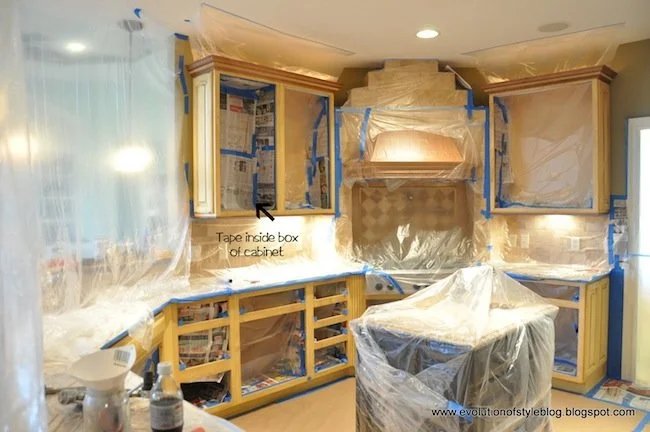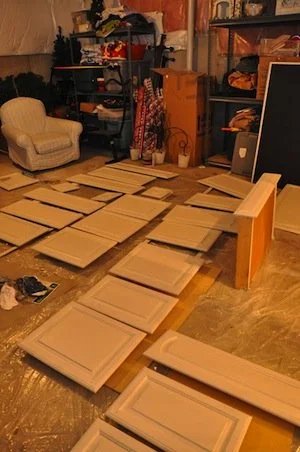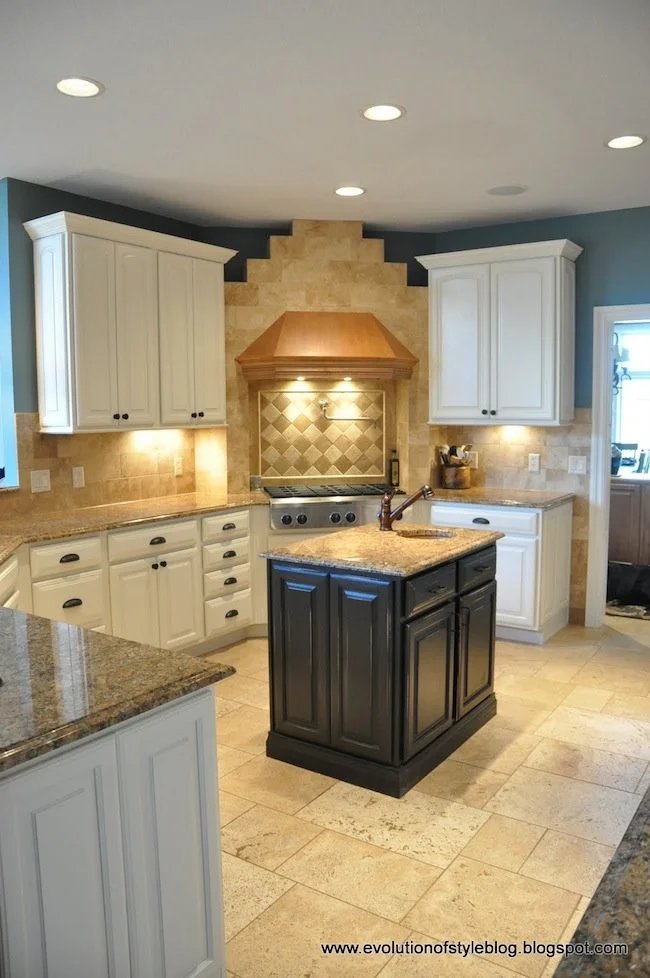

We may earn revenue from the products available on this page and participate in affiliate programs. Learn More ›
When it comes to painting cabinets, I know there are a lot of opinions and methods out there. But after I painted my kitchen island with a sprayer, I knew that doing my cabinets with a brush would not produce the look I wanted. My cabinets have a lot of raised panels, nooks, and crannies that despite my best efforts would likely ends up with drips and brush marks.
However, paint sprayers can be expensive, particularly models that hook up to a turbine. I did some research, though, and found one (the Wagner HLVP Conversion Gun of Awesomeness) that I could connect to our air compressor for a fraction of the cost.
Let’s get to the details. How did I prep my cabinets? What kind of paint did I use? What finish did I choose?
How to Paint Cabinets with a Paint Sprayer
STEP 1: Sand and Clean
Since my cabinets didn’t have a glossy finish to begin with, I started by giving them a light sanding. Then I used Krud Kutter Gloss-Off (Amazon), which is a great all-in-one cleaner AND deglosser, so with this product, you can kill two birds with one stone.
For primer and paint I used Fresh Start Superior Primer and Advance paint by Benjamin Moore. I cannot say enough good things about this Advance paint. Oh… my… goodness! As the paint-store guy/expert said, “It’s revolutionary.” As he explained it, Advance is basically an oil-based paint that acts like a latex (even though it is a latex paint). You get all of the good points of an oil-based paint with none of the negative. Though it hardens and wears like an oil, the paint cleans up like a latex—and it doesn’t smell! Revolutionary, indeed.
STEP 2: Remove Doors
Before you can really get moving, you first must remove your cabinet doors and drawers. I highly recommend putting together some sort of numbering system so that you don’t lose track of what goes where. While it all seems to make sense when you’re planning, you’ll be glad you did this when your paint-weary brain goes to put the doors and drawers back.
STEP 3: Tape
You will also need to tape off the countertops, floor, some of the ceiling, and the inside of the cabinets (walls, too, if you don’t plan on painting them in addition to your cabinets). This was by far my least favorite part of the project. Taping off the inside of cabinet frames is harder than it sounds.
Tip: Tape off the bottom, sides, and top of the frame first (newspaper works well for this), then tape off the back of the inside frame.
You can see what I mean here:

Tip: When you take off your cabinet hinges, put them in Ziploc baggies and tape them to the inside frame of that cabinet. This makes rehanging much simpler!
You will need to go all Dexter-like and tape off any open areas in your kitchen to avoid spray particles from floating through your house.
STEP 4: Get ready

You will also need to set up a staging area and a “spray booth” for painting your cabinet doors and drawers. If it’s warm enough, you can do this in your garage. I ended up setting up shop in our basement storage area. The great part about this space is that there are doors that lead to the outside, so I could open them up for ventilation. Plus, working here meant I had room to create my spray booth and there was enough space for my cabinets to dry.
The photo on the left shows the little table I set up using a piece of medium-density fiberboard. I nailed five finish nails on this board so that as I painted, the cabinet doors would be slightly elevated, and I would not have to worry about them sticking to the table top.
The same is true for the area (outside of my spray booth) where I set everything out to dry. Since I was painting both the front and the back of my cabinet doors, the nails helped keep the drips to a minimum and lowered the risk of the doors sticking to anything while drying.
Note: I obviously removed the hardware before doing this and used wood putty in one of the holes, since I was going with knobs instead of pulls. Make sure you plan out the placement of your hardware before you start painting. You’ll avoid having to make adjustments that require more priming and painting.
STEP 5: Priming and painting
Now the fun begins! Before you start spraying your cabinets, practice on a large piece of cardboard or an old box so that you can get the hang of the spray gun. It’s really very simple to use. It just takes some experimenting.
Tip: If you’re going to paint both sides of your cabinet doors, start by painting the inside of the cabinet first. That way, if you make any mistakes or have problems, you’ll learn early and it will be on an inconspicuous part of the cabinet. Plus, this way the cabinets will end up drying with the outside of the cabinet facing UP, and you won’t have to worry about any potential scratches or indentations from the nails that are used to balance your cabinets for drying. You will have a freshly painted cabinet surface when you rehang your doors.
Painting the Cabinet Doors
Start by priming the outside edge of the door with a narrow spray, making sure that you cover the outside edges of the door.
Then fill in the center area to ensure complete coverage. Carefully pick up the door and move it to the drying area. Lather. Rinse. Repeat ;-)
Once you get into a rhythm, you can paint the doors relatively quickly. Priming probably took me the longest, since I only used one coat and wanted to be sure I covered the doors really well. I followed the primer with two coats of paint.

It’s a bit of a hurry-up-and-wait kind of process. For the primer, I allowed 24 hours for each side to dry. For the paint, there’s a 16-hour wait time in between coats, which essentially amounts to a whole day for each coat. For each side.
Tip: Clean your HVLP spray gun after you’re done for the day. It’s really easy, so don’t be intimidated! All I had to do was empty the paint out of the spray cup, fill it with warm water, and spray it out until the water ran clear. (Of course, instructions are provided with the spray gun.) You don’t need to clean the needle every time, as indicated in the directions.
So, do the math: Two sides, one coat of primer, two coats of paint. You’re talking about at least a week of just painting and waiting. Then you want to let everything sit and cure a bit before rehanging. I recommend two or three days of cure time once you have completed all of the priming and painting.
While your doors are curing, you can tackle the frames (or at least that’s what I did). And really, if you want to paint the frames with a brush, you could do that and save some of the trouble. But since my frames had a lot of raised panels and I wanted the clean look that the HVLP sprayer provides, it was worth the extra prep work.
Painting the Cabinet Frames
I saved this part for last, because this is what rendered my kitchen pretty much inoperable (you’re taping EVERYTHING off in order to get a clean spray of just the frames).
The same process that worked for the doors also worked for the frames:
- Lightly sand the frames (I used 220-grit sandpaper)
- Remove excess dust and wipe clean with tack cloth
- Clean and degloss the frame surface with Krud Kutter
- Prime cabinet frames and allow to dry 24 hours
- Lightly sand and use tack cloth before painting
- Paint cabinet frames with two or three coats of paint, waiting 24 hours in between coats
- Wait two or three days for paint to cure before rehanging doors
Tip: Since gravity is working against you on the cabinet frames, I recommend using a fine spray to avoid drips as much as possible. If you do get drips, avoid sanding too much before the paint has fully cured. Wait until the paint has become more “sand-friendly.” You can touch up with a small artist’s brush.
The paint experts told me that it takes 30 days for the Advance paint to fully cure. Don’t panic—it’s not like you’re going to be working with sticky cabinet doors or anything. Just use a little extra caution in the first month.
Once your doors and frames have cured enough, the fun of putting your kitchen back together begins! From here, you can install new hardware if you have it, reinstall your hinges (or replace your old ones with new), and then rehang your doors and drawers.
Now sit back and enjoy your new kitchen!

Jenny, mother of three and self-described rookie photographer, is the unstoppable force behind the popular Evolution of Style Blog. From kitchen remodels to laundry room updates, with an undeniable gift for organization, Jenny’s talent makes her site one of our favorite places to find tips and tricks on home fix-ups.
